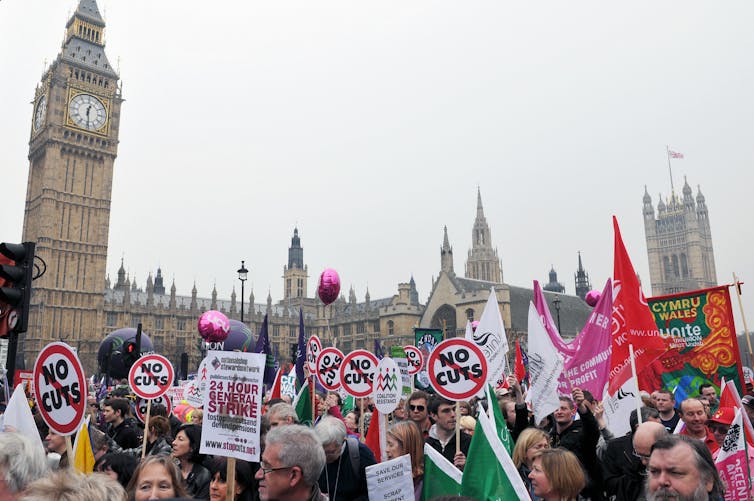
The concept of austerity featured prominently in the first round of hearings of the UK’s COVID inquiry, which has recently come to a close. Notably, former chancellor George Osborne claimed that austerity had a “positive” effect on the UK’s ability to withstand the pandemic.
Our reading of the evidence is that the austerity policies initiated after 2010 weakened the UK, allowing COVID to do more damage than it otherwise might have.
Osborne’s claim was based on the argument that, without austerity policies to “repair the UK’s public finances” following the economic recession of 2008 to 2009, “Britain would have been more exposed” to the pandemic.
Austerity measures seek to reduce government deficits, usually through a mix of public spending cuts and increased taxation. While there’s continued disagreement about whether these measures really help the economy, the evidence is clear that austerity in the UK has been bad for health.
Osborne’s 2010 austerity budget cut billions from public and welfare spending. One recent analysis estimated that austerity policies pursued between 2010 and 2019 were associated with £540 billion less public spending.
Research suggests that the “spending gap” attributed to austerity – reductions in health and social care expenditure – was 13.64% between 2010 and 2015, which may have led to 33,888 extra deaths in the same period.
Austerity acts at every point on the pathways that lead to disease and premature death. Most obviously, austerity measures make people poorer. The poorer a person is the more likely they are to suffer ill health and die younger.
Austerity measures can also make people’s lives more precarious in that they can no longer be confident that they will have income, employment, shelter or even food.
For example, cuts to welfare have been followed by large increases in food bank use over recent years. The Trussell Trust reports that the number of people receiving emergency food parcels from their food banks in the UK increased from roughly 25,000 in 2008-2009 to nearly 2 million in 2019-2020, and this number grew further by 2022-2023.
Food insecurity is associated with poor physical health and obesity, for example due to increased consumption of processed foods, which can be cheaper, or under-nutrition, through decreased access to healthy foods.
Read more: COVID: how incorrect assumptions and poor foresight hampered the UK's pandemic preparedness
The austerity policies pursued by Osborne and his successors also left the UK vulnerable to COVID in a number of specific ways.
We know groups that were already disadvantaged were hit hardest by the pandemic. They were more likely to get COVID and, if they became infected, to become severely ill and die.
The reasons are not difficult to discern. When a novel virus enters a population that has no previous immunity, its spread is determined, almost entirely, by the nature and intensity of interactions between people.
One of the ways austerity cuts harmed pandemic resilience was by increasing overcrowding in homes, which makes people more vulnerable to COVID spread, and less able to self-isolate.

Even before the British government decided, belatedly, to lock down, those who could were already restricting their interactions with others. Many began working from home, becoming familiar with new ways of interacting with colleagues online. But for many others, this was simply not possible.
Some people, for example public service workers, had multiple part-time jobs, with financial hardship linked to austerity and the cost of living crisis contributing factors.
All of this created ideal conditions for the virus to spread within families and across places of employment, such as care homes.
These problems might have been ameliorated if strong welfare protections had been in place, but they weren’t. For almost a decade, governments had been chipping away at social support systems, with people who were old or disabled especially hard hit. By the mid-2010s, life expectancy at older ages had begun declining.
As a result of austerity measures, social care spending, which rose between 2001 and 2010, started falling between 2010 and 2015 (taking inflation into account). This meant the resilience of the social care system was significantly weakened going into the pandemic.
Older people’s plight was exacerbated by the abysmal state of the housing stock, with the least efficient heat retention in Europe.
Funding cuts to local authorities have contributed to cold homes, less energy-efficient housing, and greater fuel poverty, which in turn negatively affect health. Older people are more likely to be vulnerable to the cold, including in poorly insulated homes, because they’re more likely to have existing medical conditions.
Read more: The lie at the heart of austerity just makes inequality worse
Then there was the NHS. Owing partly to the spending gap mentioned earlier, investment in health infrastructure, from diagnostic scanners to IT infrastructure, had almost dried up. Facilities were literally falling apart.
Cuts to medical and nursing training have been a major factor in the chronic staff shortages we now see, with places often filled by locum or agency staff. These staff are not only more expensive but often unfamiliar with their working environment.
Paradoxically, spending cuts promoted as means to increase efficiency ultimately had the opposite effect.
Preparing for the next crisis
Any argument that austerity placed the country’s economy on a sounder footing than would otherwise have been the case, making it better rather than worse prepared when the pandemic came, is misguided.
Leaving aside the questionable economics, this is akin to arguing that a ship’s captain should skimp on lifeboats so that he can send the cabin boy out to buy some when the ship is about to hit the iceberg.
Austerity policies shred the safety nets that those most economically vulnerable would otherwise depend on. Then, when people fall ill, these measures weaken the ability of health services to care for them.
The COVID pandemic will not be the last. One of the best things we can do to prepare for future pandemics is to avoid a return to austerity.
Simon Nicholas Williams has received funding from Senedd Cymru, Public Health Wales and the Wales Covid Evidence Centre for research on COVID-19, and has consulted for the World Health Organization. However, this article reflects the views of the author only, in his academic capacity at Swansea University, and no funding or organizational bodies were involved in the writing or content of this article.
Martin McKee is the immediate past president of the British Medical Association and the European Public Health Association. He is not affiliated to any political party. His research is funded by UKRI, the Wellcome Trust, and Horizon Europe.
This article was originally published on The Conversation. Read the original article.







